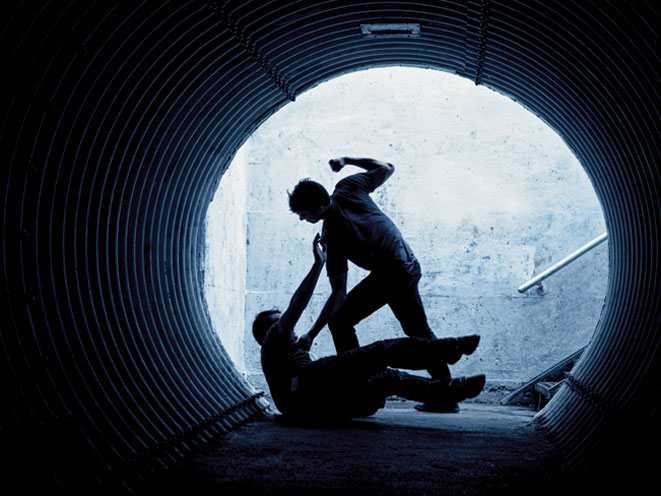The legislation establishes a number of circumstances, the presence of which excludes the crime of an act. One of them is the necessary defense. In this case, the subject who committed, in fact, an unlawful act, can avoid responsibility under certain conditions. In particular, he must not exceed the permissible limits of defense. We will talk about the legality of the actions of entities forced to apply protective measures in emergency situations.

General information
Under the necessary defense should be understood actions aimed at protecting the rights and personality of the defending or other entity, the interests of the state and society by causing harm to the attacker within the permissible limits.
The legitimacy of the necessary defense is recognized if:
- A criminal assault of particular danger.
- Real threat.
- Harm exclusively to the attacker, but not to outsiders. Otherwise, the rules of emergency are subject to application.
- The real danger to life.
In this case, the defending person should not go beyond the necessary defense.
Features of the circumstances of the application of protective measures
The necessary defense is allowed only in the presence of a criminal assault that is dangerous. In particular, protection measures can be applied when:
- Actions / inaction of citizens.
- Intentional and reckless crimes of individuals.
- Clearly illegal actions by officials.
The necessary defense can be applied exclusively against acts for which responsibility arises under the Criminal Code. In this case, the subjects of such crimes may be insane or minors. In such situations, the defender has a moral obligation not to cause significant harm to the attacker, since he does not realize the nature and danger of his behavior and cannot control it.
The necessary defense can be used by an outsider to protect another citizen, the interests of society and the state. For example, a young man on the street protected his girlfriend from a bully and inflicted bodily harm on him. Such actions of a young man will be considered legitimate.
The necessary defense cannot be applied when the subject commits legal actions. For example, if a citizen is detained and does not resist, harming him will be illegal.
Given the specifics of the necessary defense, we can say that it is allowed only from those attacks that can be prevented only through the use of physical force against the attacker. Therefore, it is difficult to imagine its expediency, for example, in relation to the malicious defaulter of alimony.
Cash and validity of the offense
These signs mean that the unlawful action has begun and is actually threatening or is already causing harm and has not yet completed. Accordingly, it is impractical to expect a first strike. However, one cannot defend oneself if there is no threat of a sudden onset of illegal action.

The necessary defense is not allowed after the end of the assault, if:
- The attacker reached the goal. For example, the victim died, respectively, protection measures will no longer help him.
- The defender was able to prevent illegal action; threat to interests eliminated. Such a situation must be distinguished from cases where the person does not understand the moment the assault was completed, although on objective grounds the attacker is no longer a danger.
For example, a citizen, defending himself, shot a man, from which he fell and could not rise. However, the defender after this struck the wounded man several times with a butt on the head, until he finally calmed down. In this case, the defender will be responsible for the actions that he performed after the end of the attack, that is, from the moment the citizen fell from injury.
Threat to life
If available, the right to defense arises without any restrictions. So, it can be recognized as legitimate to cause death to persons who closed the debtor in the cold in the garage and suggested that he "think" about how he would repay his debts. In such situations, the victim has the right not to correlate defensive actions with the nature of the assault. This is due to the fact that:
- Human life is considered the highest value; accordingly, a variety of methods can be used to protect it.
- In a critical situation, the victim cannot adequately assess what is happening.
Excess of necessary defense measures
When defending against attack, a certain framework must be respected. Exceeding the necessary defense involves the commission of deliberate actions that clearly do not correspond to the degree and nature of the danger emanating from the attacker.
The word “explicit” in the above wording does not provide for proportionality between the harm that occurred during the defense and the threatening harm (coming from another person). The correspondence between the means / instruments of attack and defense may be absent.
It is not allowed only to cause unnecessarily serious damage that was not caused by necessity, that is, it was not advisable.

The court assesses the degree of evidence of the mismatch between the attack and defense in each specific situation. In this case, all the circumstances of the incident in the complex are studied. The following are taken into account:
- the severity of the likely damage;
- reality of threats;
- features of weapons of defense and attack;
- intensity of attack;
- time of day;
- age, gender, mental state of the parties to the conflict.
For example, leaving the poisoned alcohol on the table to cause harm to the health of an apartment thief would be considered an excess of the necessary defense.
Actions that clearly do not correspond to the attack must be committed intentionally. Damage to the protection of low-value goods will be qualified as a common crime, but not as exceeding the limits of necessary defense. For example, a citizen, chasing minors who climbed into his garden, hit one of the teenagers with a stick in the head. The victim died from his injuries. As a result, a citizen was held accountable for the murder.
If the limits of the necessary defense are exceeded, there is no effect of surprise encroachment. This means that the actions of the attacker were not swift to such an extent that the defender was not able to adequately assess the nature and degree of danger of what is happening.
Nuance
The use of protective devices, various mechanisms, the use of animals to suppress dangerous acts is allowed, if this excludes the possibility of harming innocent entities and causing excessive harm to the guilty. For example, mining a garden, placing along the perimeter of a section of high-voltage wire, gunshots, etc., will entail liability for the citizen if damage arises from this.
The provisions of the Criminal Code
The excess of the necessary defense is stated in part 1 of article 37 of the Criminal Code. The norm stipulates that causing damage to an encroaching subject is not considered a crime if the encroachment was accompanied by life-threatening violence or the threat of its use. It follows that no matter how serious the consequences may turn out, responsibility for protecting the subject of his interests or the interests of other persons, the state or society does not arise.

In part 2 of the norm, a sign of the legitimacy of the use of defensive measures is indicated. Punishment for the harm done will not occur if the necessary defense is not allowed to be exceeded.
Responsibility, within the meaning of Article 37 of the Criminal Code, is provided for intentional actions of the defender. Crimes committed when the limits of the necessary defense are exceeded are qualified using extenuating circumstances.
Event rating features
To impose liability under the Criminal Code in excess of the necessary defense, it is necessary first of all to establish whether it was at all. If it was not, then the actions of the subject should be recognized as unlawful.
In the case of a murder committed when exceeding the limits of the necessary defense, it is necessary to find out whether there was a mismatch between the protection of the nature and degree of danger of the attack. It is precisely this criterion that art. 13 of the Criminal Code. The presence of this feature in the legislation greatly facilitates the work of investigative and judicial authorities. However, as practice shows, not in all cases the question of the absence or presence of excess of necessary defense is resolved correctly by authorized structures. The fact is that in many aspects of this problem, unified approaches have not been developed.
The wording, which is present in Part 2 of Article 13 of the Code, gives reason to believe that the limits of defense can be exceeded both due to the disproportion of defense and attack, and due to the untimely actions of the defending person. As practice shows, cases of the first category are more common than the second.
Qualification Mistakes
Often, the deprivation of an encroaching citizen's life is mistakenly recognized as a murder committed when the necessary defense is exceeded. The intentionality of actions is ascertained in the case when the intensity of the protective measures or means of defense clearly does not correspond to the activity of the attack or its means.

The Supreme Court has repeatedly provided clarifications on issues of incorrect qualifications. In particular, the Armed Forces considers the position of the authorities, which believe that the defender has the right to repel an attack exclusively by proportional means, to be incorrect. In this approach, specific circumstances are not taken into account, and therefore, in the absence of a correspondence between the attack and defense, the courts recognize that the limits of the necessary defense are exceeded.
The Criminal Code does not provide specific criteria for proportionality. However, this does not mean that the courts must mechanically follow the requirements for compliance with the means and intensity of the attack and defense. Institutions must take into account both the nature and degree of danger of the attacker, the ability and strength of the defender. It is necessary to find out how many participants in the conflict were, what their age was, whether weapons were used, at what time and where the assault was committed. Other factors that could affect the balance of power should also be taken into account.
Compliance of protected interest with harm
As mentioned above, it is possible to recognize the actions of the defender as a crime committed if the limits of the necessary defense are exceeded, if it is established that the protected good was not so valuable as to inflict grievous harm on the encroaching citizen. In this regard, one can recognize the correct approach, according to which one can defend oneself from an attack that threatens life and health. In this case, of course, there should be no danger to unauthorized persons.
However, this does not mean that one cannot defend oneself from an attack that does not pose a threat to life, the use of which can lead to grave consequences for the offender. For example, a woman who has been the victim of an attempted rape can use any means of protection and thereby cause serious damage to the perpetrator.

As practice shows, the courts do not always correctly determine the value of the good in relation to which an encroachment is committed. In some cases, the ability to use the necessary defense is recognized by the subject if he or his rights become the object of a crime. Meanwhile, citizens have the right to protection in case of encroachment on the interests of the individual, state, society, interests of other persons. It is worth noting that often under the criminal assault the courts understand only those offenses that are associated with the attack. However, citizens, by virtue of the law, have the right to apply defensive measures in other crimes.
Conformity of attack and defense
In resolving this issue, it is necessary to establish which object the attacker used and how the defender defended himself. In this case, the extreme nature of the situation should be taken into account. The defender is far from always able to adequately assess the situation, weigh the nature of the threat, and on the basis of this choose the appropriate remedy. This, in turn, can lead to grave consequences for which liability should not be imposed.
In determining the proportionality of the means of encroachment and defense, as a rule, the question arises of the legality of the use of weapons or their replacement items. The investigating authorities and the courts decide it in each case, initiated in connection with the onset of grave consequences, which led to the excess of necessary defense. Murder is considered the most dangerous consequence of the disproportionate actions of the defender.
Aspect ratio
Consideration of this circumstance may be crucial in qualifying the actions of the defender in the event of murder. If the limits of the necessary defense are exceeded, one cannot ignore the ability of the defender to repulse the attack. It matters gender, physical fitness, age of the defender.
For example, when repelling an attack by an unarmed but physically strong man, a pensioner or adolescent should justify the use of weapons or other equivalent items as a means of protection. Accordingly, causing death to a weak attacker who does not have the necessary physical strength can be recognized as murder if the limits of the necessary defense are exceeded.

Features
Equally important are the conditions under which a conflict occurs. For example, on a deserted street or in a forest during an attack, more active means of defense are assumed than with an encroachment committed in a public place. In the latter case, the defender has the opportunity to resort to the help of others.
Conclusion
The presence in the legislation of norms governing the application of necessary defense measures ensures the implementation of the most important guarantees of protecting the health, honor, life, dignity of citizens, public safety, and state interests.
The limits of the necessity of the actions of persons reflecting the attack are determined by the specific conditions under which they are committed.
